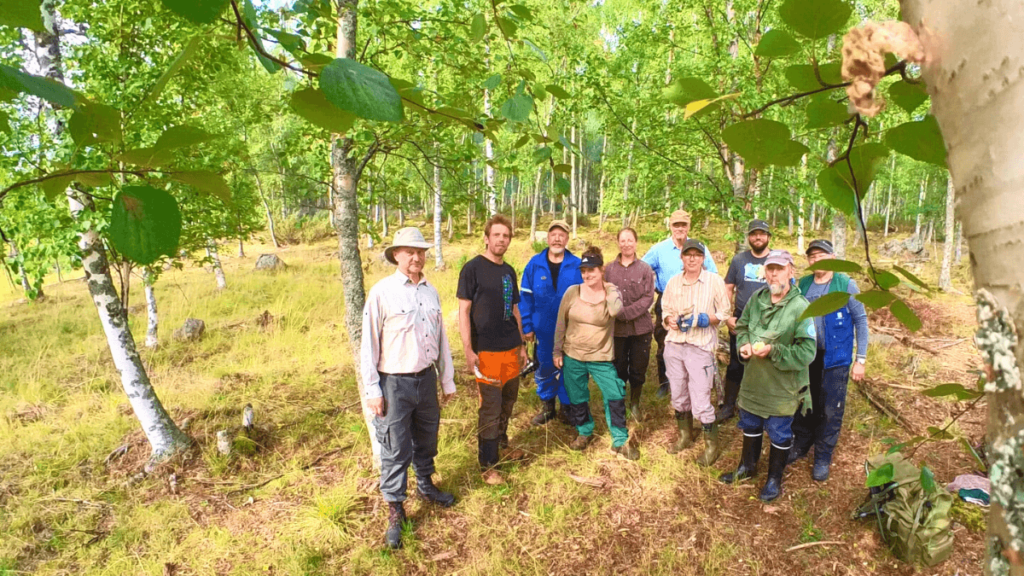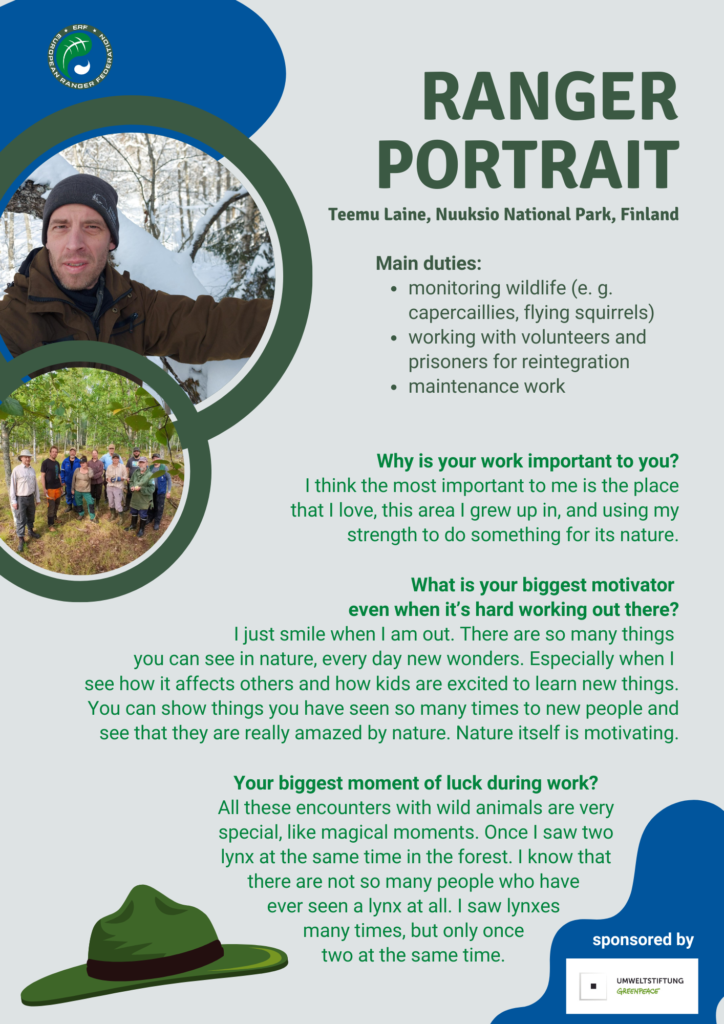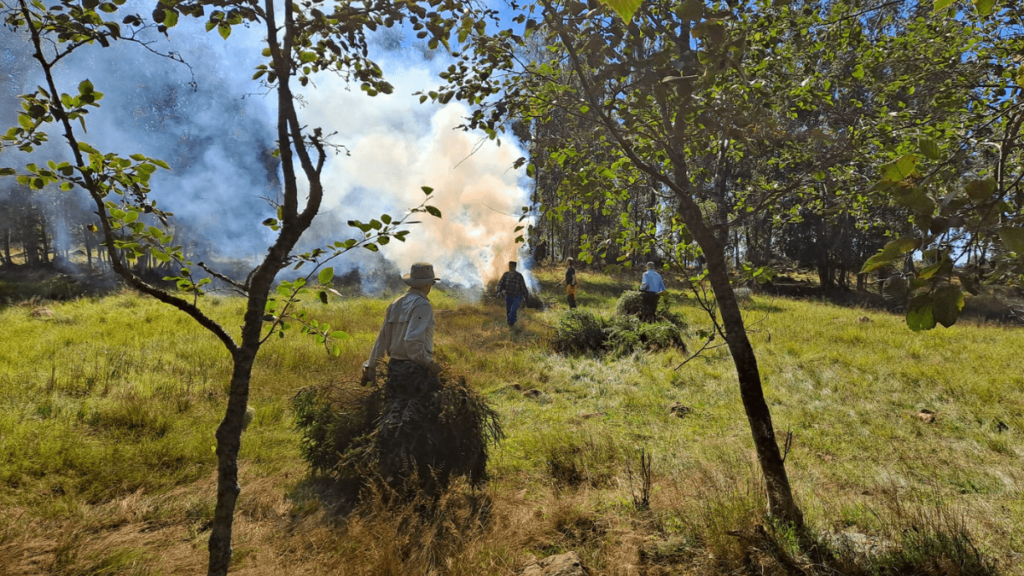Being a ranger in Finland: In Nuuksio national park this often means working a lot with volunteers, but also prisoners. It does for Teemu Laine: the spokesperson of the Finnish ranger association Suomen Rangerit and field supervisor in Nuuksio national park, one of 41 national parks in Finland, talked to us about rangering and the goals of his association.
It is working to support professional rangers, for example through twinning partnerships or covering the costs of training. For our series on national associations Teemu tells us why he would like to see more interest among professional rangers in further training. And he also explains how necessary he thinks it is to have a Europe-wide management system for protected areas .
Teemu, what are the issues that rangers like you deal with in Finland?
I do monitoring tasks in the areas of capercaillies, flying squirrels and other animals. But I mainly work with volunteers and also with convicts within the frame of an open prison concept in Nuuksio national park and government owned areas around the capital. We have a lot of visitors in a small area, because there is not much nature left close to Helsinki. In contrast to the parks further north our visitors are mainly local people. Working with them often means explaining why we do what we do, as we do with the convicts. They work with us at the end of their sentence to prepare for their return into life after prison and get some money out of it. They are sent to us to help in the basic maintenance of the national park like making firewood for the fire places, cleaning up etc. Normally, they have other interests than nature. So on their first days of work, they often react with eyes wide open seeing an animal for example, asking “How come I see this Moose here, is this some sort of Zoo?”
Is there a difference in working with convicts and volunteers?
Most volunteers ask many questions themselves and are really interested. Working with the governmental organisation Parks and Wildlife Finland from Metsähallitus, which manages state-owned lands and waters all over the country, I see that there is a great interest in Finland to do volunteer work in national parks. Companies were contacting us to volunteer with us during working time for example. I also work with Junior Rangers. In 2007 we participated in Europarc Junior Rangers training and started this project in Finland. Like with the company’s volunteers, I go out with them for a few hours and explain our work and the backgrounds of conservation. I remember myself saying I would rather work with Junior Rangers than with criminals. But of course I see the great value of having the latter working in nature, for which they usually did not have much respect before. Although they usually did not choose the work themselves, they probably get some deeper meaning of nature for themselves from this work, become better persons and realise how good it was for them to do this work.

How to become a ranger in Finland?
There isn’t any special training or study. For example, I grew up in the area where the national park was established, moving around in its forest and lakes with my friends when I was younger. I remember that some day I saw someone with the national park logo and asked “Are you working here?”. So I realized the opportunity to work where I enjoy being anyway. Later on I went through a basic education for nature and environmental subjects at a special school and training through a few work opportunities, also with Metsähallitus for the National Park itself. As most rangers working in the park have a background as forestry engineers I learned forestry engineering. So after many contracts I found myself here in the National Park. Here I am still and I really like the work.
Who do rangers in Finland work for and which rangers does your association represent?
Rangers usually work for governmental organizations responsible for the national parks. There also are a lot of contracted companies dealing with nature tourism, which are quite often helping in our work, doing their part of giving information about nature and the National Park. In our association we have also opened up for other professional rangers working for such non-governmental organisations. Today anyone can apply, also volunteers wanting to work in protected areas. We try to promote professional rangers, but there is not much interest at the moment. For example we established a twinning partnership with Danish rangers. The Danish rangers have already been here, but we have not yet been able to organise a counter visit due to a lack of registrations.

What are the biggest challenges rangers in Finland face? And what could rangers in Europe particularly learn from Finnish rangers?
We are constantly experiencing changes in the systems we work with, for example the digital platform for visitor management. Some rangers who have a background like forestry and are used to working silently and lonely do not really want to work with people or any digital systems. But the modern way of working is forcing them to do so. For some this is really hard and even causes health issues. At the same time the digital system is something we succeeded in because we get money from the government while there have been budget cuts in many other areas like museums or historical sites.
“I think it would be really good to have a management system for protected areas that covers all of Europe. Almost every national park for instance has a different kind of signage.”
Teemu Laine, ranger and spokesperson of the Finnish Ranger Association
We have been active in developing the system within Parks and Wildlife Finland giving live information about our work: Is there firewood at the fireplace, where is there construction or maintenance work? Also we are doing visitor counts like nobody else does in Finland. We can provide numbers on the amount of visitors, what they need and seek. But talking about learning from each other: Last autumn we visited Tyresta National Park in Sweden. It was amazing and also kind of stupid to see that we are using taxpayers’ money to do the same kind of things in both countries. I think it would be really good to have a management system for protected areas that covers all of Europe. Almost every national park for instance has a different kind of signage. Why not use the same signs people are already familiar with from their home countries?
editorial work for this
content is supported by


